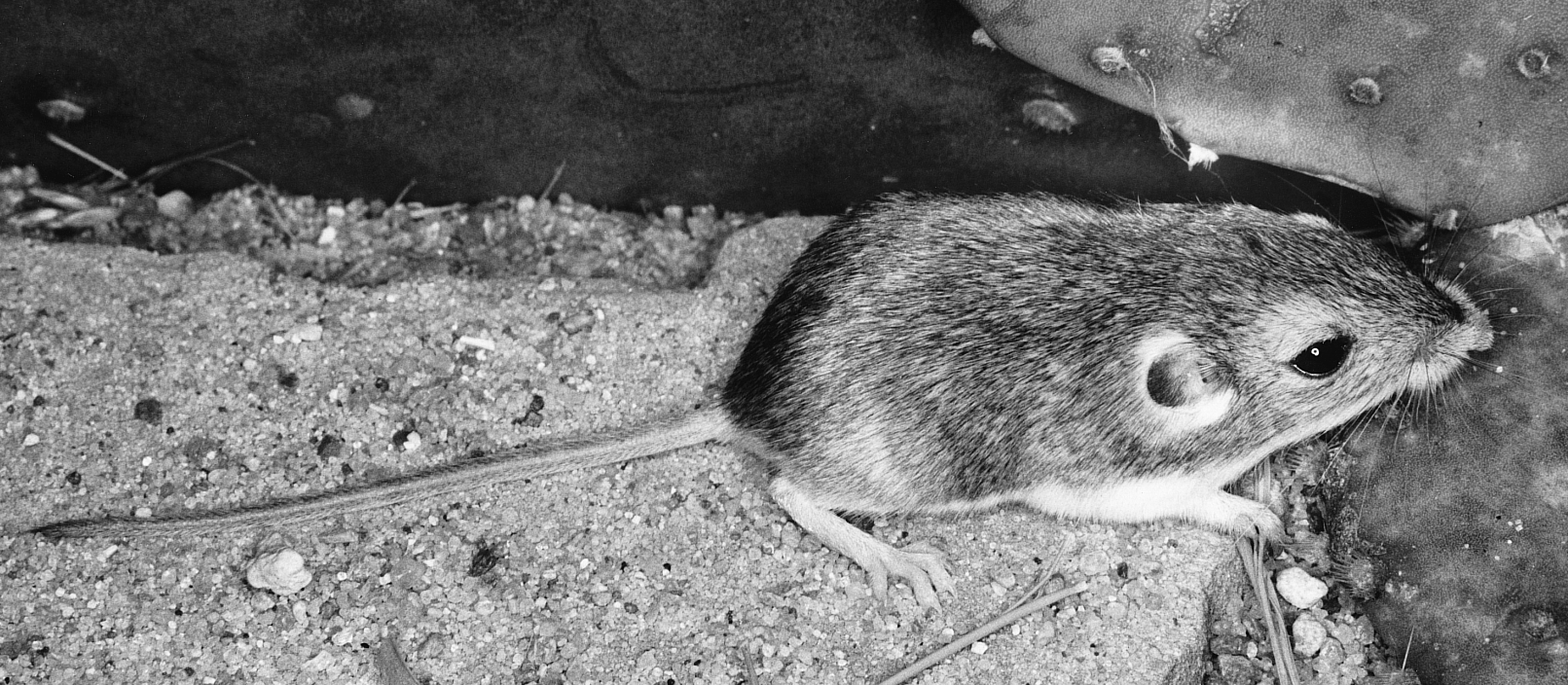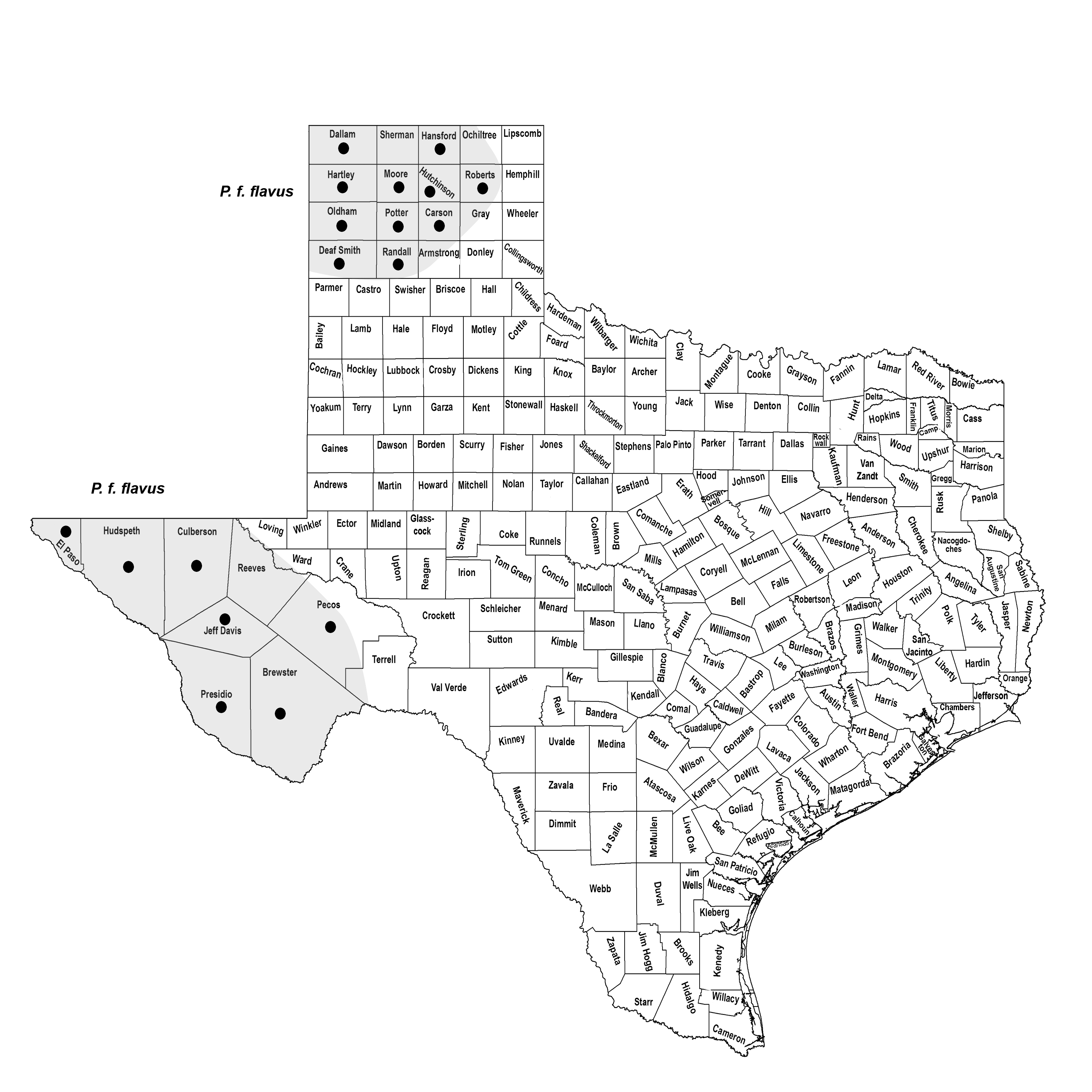SILKY POCKET MOUSE
Perognathus flavus Baird 1855
Order Rodentia : Family Heteromyidae
DESCRIPTION. A small pocket mouse with soft, silky fur, short ears, and short, sparsely haired tail; upperparts pinkish buff, lightly mixed with black; underparts pure white; spot behind ear clear buff and conspicuous; ears light buff on outside, blackish inside; tail pale buffy, slightly darker above. Closely resembles P. merriami, from which it differs in the frequency of biochemical genetic markers and in features of the skull such as larger auditory bullae and a more square interparietal bone. Dental formula: I 1/1, C 0/0, Pm 1/1, M 3/3 × 2 = 20. Averages for external measurements: total length, 113 mm; tail, 50 mm; hind foot, 16 mm. Weight, 6–8 g.

DISTRIBUTION. Known from the Trans-Pecos and northern Panhandle.

SUBSPECIES. Probably P. f. flavus, although some questions remain regarding the taxonomy of this species.
HABITS. Silky pocket mice appear to be more tolerant of habitat conditions than some of the other species of small pocket mice. In some areas they are found in rocky situations; in others on hard, stony soils; and in others on sands. In most localities, however, they occur on medium soils of valley bottoms where they live among the scattered weeds and shrubs and burrow in the sand.
As with other species of pocket mice, the burrows of P. flavus are simple in design, usually shallow and barely large enough to admit a man's finger. One excavated near Sierra Blanca, Texas, was in the bank of a dike thrown up to divert water from the highway. The three openings converged to a single burrow that led along the dike for a distance of about 1 m, at no place penetrating >10 cm below the surface. Two side branches diverged from the main burrow, one of them sloping upward to near the surface. This branch probably was a duck-out, because the occupant escaped from it by breaking through the thin crust of earth at the blind end of the tunnel. No nest or store of food was encountered, although this mouse is known to store food.
Perognathus flavus is nocturnal but occasionally may be active outside its burrow during the day. At night it forages for seeds, which are collected and cached in its burrow for consumption the following day. Perognathus flavus also will feed on green vegetation, juniper berries, and occasionally invertebrates.
The breeding season extends from early spring to late fall. Half-grown young have been captured as early as 16 April and as late as 23 September, with other records on 28 May and 3 July. A lactating female was captured in December, and pregnant females have been documented in May, June, August, and October. Probably two or more litters of two to six young are reared each season. Nothing is known of the growth and development of the young and the family relations. An adult female lived in captivity for >5 years, but the age attained in the wild is probably not more than 2 or 3 years.
POPULATION STATUS. Common. The silky pocket mouse is common throughout its range in the state.
CONSERVATION STATUS. The IUCN lists the silky pocket mouse as a species of least concern, and it does not appear on the federal or state lists of concerned species. It does not appear to face any immediate threats.
REMARKS. The taxonomic status of P. flavus has been confusing. See account for P. merriami for a discussion.
From The Mammals of Texas, Seventh Edition by David J. Schmidly and Robert D. Bradley, copyright © 1994, 2004, 2016. Courtesy of the University of Texas Press.
Natural Science Research Laboratory
-
Address
Museum of Texas Tech University, 3301 4th street, Lubbock, TX 79409 -
Phone
806.742.2486 -
Email
nsrl.museum@ttu.edu

